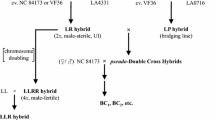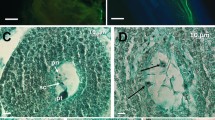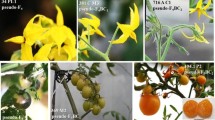Summary
Treatment of Lycopersicon peruvianum stigmas with an artificial medium analogous to stigmatic exudate allowed pollen germination and growth on immature pistils. Growth of Lycopersicon esculentum pollen tubes to L. peruvianum ovules, an otherwise incompatible cross, was achieved following such treated bud-pollinations. No plantlets were recovered, although a few embryos from this cross at the globularity heart stage of development were excised at 22 days after pollination, indicating the presence of crossing failures as severe as in the reciprocal cross. Hybrid plants were obtained from the reciprocal cross, using as pollen parent an L. peruvianum line selected for congruity with L. esculentum. Bud pollinations to L. peruvianum, using these interspecific F1 hybrids as the pollen parent, allowed viable embryo development and plantlet recovery. Resulting backcross plants, which possess approximately 1/4 L. esculentum genome in a L. peruvianum cytoplasm, may facilitate further introgression of the L. esculentum nuclear genes into in foreign cytoplasm.
Similar content being viewed by others
References
Alexander, L.J., 1963. Transfer of a dominant type of resistance to the four known Ohio pathogenic strains of tobacco mosaic virus (TMV) from Lycopersicon peruvianum to L. esculentum. Phytopathology 53: 869.
Anderson, R., 1964. Evidence of plasmon differentiation in Lycopersicon. Tomato Genetics Coop. Rpt. 14: 4–6.
Barbano, P.P. & L.D., Topoleski, 1984. Postfertilization hybrid seed failure in Lycopersicon esculentum x Lycopersicon peruvianum ovules. J. Amer. Soc. Hort. Sci. 109: 95–100.
Choudhury, B., 1959a. Development of seed and its parts. Hybrid seed of Lycopersicon esculentum and Lycopersicon peruvianum. Ind. J. Hort. 16: 23–30.
Choudhury, B., 1959b. Hybridization between Lycopersicon esculentum Mill. and Lycopersicon peruvianum Mill. Ind. J. Hort. 16: 102–107.
Gilbert, J.C. & D.C., McGuire, 1956. Inheritance of resistance to severe root-knot from Meloidogyne incognita in commercial type tomatoes. Proc. Am. Soc. Hort. Sci. 68: 437–442.
Gradziel, T. & R.W., Robinson, 1985. Overcoming stylar incompatibility in Solanum and Lycopersicon by using bud pollination under high humidity. Plant Cell Incompatibility Newsletter 17: 13.
Gradziel, T. & R.W., Robinson, 1989a. Solanum lycopersicoides gene introgression to tomato, Lycopersicon esculentum, through the systematic avoidance and suppression of breeding barriers. Sex Plant Reprod. 2: 43–52.
Gradziel, T. & R.W., Robinson, 1989b. Breakdown of self-in-compatibility during pistil development in Lycopersicon peruvianum by modified bud pollination. Sex Plant Reprod. 2: 38–42.
Gunther, E., 1964. Reciproke bastarde zwischen Lycopersicon peruvianum L. Mill. Naturwissenschaften 18: 443–444.
Hodosy, S. & H.F., Kiss, 1975. Choice of variety and the role of resistance against a background of damage due to tomato blight epidemics. Zoldsegtermesztesi Kutato Intezet Bulletinje 9: 51–56.
Hogenboom, N.G., 1970. Inheritance of resistance to corky root in tomato (Lycopersicon esculentum Mill.) Euphytica 19: 421–425.
Hogenboom, N.G., 1972a. Breaking breeding barriers in Lycopersicon. 4. Breakdown of unilateral incompatibility between L. peruvianum L. Mill. and L. esculentum. Euphytica 21: 397–404.
Hogenboom, N.G., 1972b. Breaking breeding barriers in Lycopersicon. 5. The inheritance of the unilateral incompatability between L. peruvianum L. Mill. and L. esculentum Mill. and the genetics of its breakdown. Euphytica 21: 405–414.
Jacquemond, M. & H. Laterrot, 1981. Compartament vis-a-vis de la ‘Necrose de la tomate’ des genitcurs utilises pour la resistance au CMV. Proc. Eucarpia Tomato Working Group, May 1981 pp. 243–249.
Kho, Y.O. & J., Baer, 1968. Observing pollen tubes by means of fluorescence. Euphytica 17: 298–302.
Laterrot, H., R., Brand & M.L., Daunay, 1978. Resistance to Corynebacterium michiganensis in the tomato; review of literature. Ann. Amelior. Plant. 28: 579–591.
Lewis, D. & L.K., Crowe, 1958. Unilateral incompatability in flowering plants. Heredity 12: 223–256.
Martin, F.M., 1961. The inheritance of self-incompatibility in hybrids of Lycopersicon esculentum Mill. x L. chilense Dun. Genetics 46: 1443–1454.
Martin, M.W., 1970. Developing tomatoes resistant to curly top virus. Euphytica 19: 243–252.
Marubashi, W. & T., Nakajima, 1981. Pollen tube behavior in the ovary of Nicotiana tabacum L. Japan J. Breed. 32: 133–140.
McGuire, D. & C.M., Rick, 1954. Self-incompatibility in species of Lycopersicon sect. Eriopersicon and hybrids with Lycopersicon esculentum. Hilgardia 23: 101–124.
Munger, H.M. & D., Lane, 1983. An improved method of BA application for the promotion of fruit set in muskmelon. Cucurbit Genetics Coop. Rpt. 6: 51.
Mutschler, M.A. & E., Cobb, 1985. Crosses of Lycopersicon pennellii and Lycopersicon esculentum using Lycopersicon pennellii as the female parent. Tomato Genet. Coop. Rpt. 35: 14.
Neal, C.A. & L.D., Topoleski, 1983. Effects of the basal medium on growth of immature tomato embryoes in vitro. J. Amer. Soc. Hort. Sci. 108: 434–438.
Neal, C.A. & L.D., Topoleski, 1985. Hormonal regulation of growth and development of tomato embryos in vitro. J. Amer. Soc. Hort. Sci. 110: 869–873.
de, Nettancourt, D., 1977. Incompatibility in Angiosperms. Monographs on Theoretical and Applied Genetics 3. Springer-Verlag, New York.
de, Nattencourt, D., M., Devreux, U., Laneri, M., Cresti, E., Pacini & G., Sarfatti, 1974. Genetical and ultrastructural aspects of self and cross incompatibility in interspecific hybrids between self-compatible Lycopersicon esculentum and self-incompatiblie L. peruvianum. Theor. Appl. Genet. 44: 278–288.
Pilowsky, M. & S., Cohen, 1990. Tolerance to tomato yellow leaf curl virus derived from Lycopersicon peruvianum. Plant Disease 74: 248–250.
Raghavan, V. & J.G., Torrey, 1963. Growth and morphogenesis of globular and older embryos of Capsella in culture. Amer. J. Bot. 50: 540–551.
Rick, C.M., 1963. Barriers to interbreeding in Lycopersicon. Evolution 17: 216–232.
Rick, C.M., 1967. Exploiting species hybrids for vegetable improvement. Proc. of the XVIIth Int. Hort. Congress 3: 217–299.
Rick, C.M., 1979a. Tomato germplasm resources: In: AVRDC, Proc. First International Symposium Tropical Tomato, Shanhua. Taiwan. p. 214–224.
Rick, C.M., 1979b. Potential improvement of tomatocs by controlled introgression of genes from wild species. In: A.C. Zeven & A.M. van Harten (Eds.). Proc. Conf. Broadening Genet. Base Crops. Wageningen. The Netherlands, p. 167–173.
Rick, C.M., 1983. Crossability between L. esculentum and a new race of L. peruvianum. Tomato Genet Coop Rpt 33: 13.
Rick, C.M. & D., Hunt. 1953. The use of growth-promoting substances as an aid in tomato breeding. Tomato Genetics Coop. Rpt. 3: 22–23.
Rick, C.M. & P.G., Smith, 1953. Novel variation in tomato species hybrids. Amer. Nat. 87: 359–373.
Rick, C.M., J.W., DeVerna, R.T., Chetelat & M.A., Stevens. 1986. Meiosis in sesquidiploid hybrids of Lycopersicon esculentum and Solanum lycopersicoides. Proc. Nat. Acad. Sci. (U. S. A.) 83: 3580–3583.
Saccardo, F., G. Ancora & K. Sree-Ramulu, 1981. Transfer of useful characters from Lycopersicon peruvianum to Lycopersicon esculentum tomato hybrids. Proc. Eucarpia Tomato Working Group May, 1981, pp. 235–242.
Smith, P.G., 1944. Embryo culture of a tomato species hybrid. Proc. Amer. Soc. Hort. Sci. 44: 413–416.
Tal, M., 1971. Salt tolerance in the wild relatives of the culevated tomato. Response of Lycopersicon esculentum. L. peruvianum, and L. esculentum minor to sodium chloride solution. Austr. J. Agr. Res. 22: 631–638.
Visser, T. & M.C., Marcucci, 1983. Pollen and pollination experiments. IX. The pioncer pollen effect in apple and peat related to the interval between pollinations and the temperature. Euphytica 32: 703–709.
Warmke, H.E. & A.F., Blakeslec. 1939. Induction of simple and multiple polyploidy in Nicotiana by colchicine treatment. J. Hered. 30: 419–432.
Yamakawa, K., H. Yasui, T. Mochizuki, K. Hida & S. Komuchi. 1987. Incorporation of disease resistance from Lycopersicon peruvianum to cultivated tomatoes. I. Breeding of new varieties having resistance to fusarium crown rot and tobacco mosaic virus inherited from Lycopersicon peruvianum. Bull. Natl. Res. Int Veg. & Ornamental Plants Tea Ser. A. (1): 1–38.
Yamakawa, K., H. Yasui, T. Mochizuki, K. Hida & S. Komuchi, 1988. Incorporation of disease resistance from Lycopersicon peruvianum to cultivated tomatoes. II New breeding stocks Tomato Ano No. 1 and No. 2 having leaf mold resistance inherited from Lycopersicon peruvianum. Bull. Natl. Res. Inst. Veg. & Ornamental Plants Tea Ser N. (2) 1–28.
Author information
Authors and Affiliations
Rights and permissions
About this article
Cite this article
Gradziel, T.M., Robinson, R.W. Overcoming unilateral breeding barriers between Lycopersicon peruvianum and cultivated tomato, Lycopersicon esculentum . Euphytica 54, 1–9 (1991). https://doi.org/10.1007/BF00145624
Received:
Accepted:
Issue Date:
DOI: https://doi.org/10.1007/BF00145624




